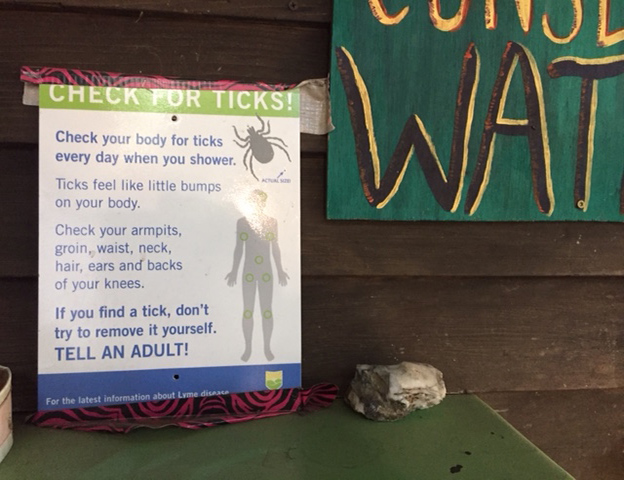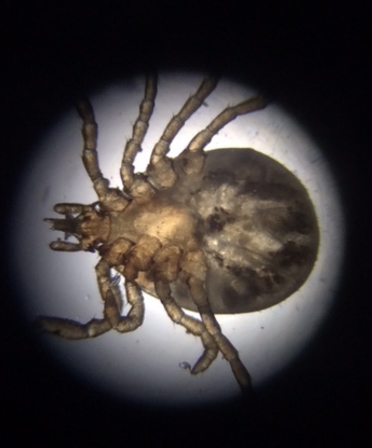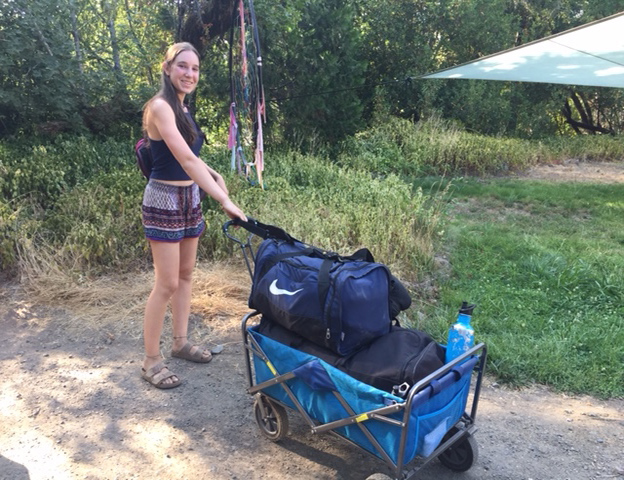 The following is a guest post by one of our esteemed Advisory Board members, Lia Gaertner. Lia is a scientist and also a Lyme patient who has turned her own frustrating experience with the disease into a personal mission to help create greater awareness and understanding about the illness. This year’s explosion in tick counts all over the country necessitates extra vigilance for all of us who enjoy the outdoors. Here, Lia shares some of her family’s precautions.
The following is a guest post by one of our esteemed Advisory Board members, Lia Gaertner. Lia is a scientist and also a Lyme patient who has turned her own frustrating experience with the disease into a personal mission to help create greater awareness and understanding about the illness. This year’s explosion in tick counts all over the country necessitates extra vigilance for all of us who enjoy the outdoors. Here, Lia shares some of her family’s precautions.
I am proud to serve as a member of the science team at the Bay Area Lyme Foundation (BAL). As a survivor of two severe Lyme infections on both the East and West coasts of the USA, I know quite a bit about ticks and tick-borne infections. During my twelve-year struggle with Lyme and babesia infections, my physician husband and I had to educate ourselves about ticks and tick-borne infections by going to medical conferences, studying with doctors, reading scientific literature, and mostly by experimenting with dozens of tests and therapies (on me). Now, we both receive daily requests from desperate people who cannot find sufficient information on how to treat their tick bite or tick-borne infections.
This year is being reported to be the worst year for ticks and tick-borne infections ever. Needless to say, both my husband and I are very wary of ticks here in California, across the USA, and around the world. We know of people who have contracted Lyme and other tick-borne infections in the Bay Area, Los Angeles, China, Mexico, Switzerland, Africa, Denmark, … and the list goes on.
Where we live in California, one of the highest rates of Lyme infected ticks is found in Mendocino county where the odds of contracting an infection are similar to those of the East Coast. So, what do parents like us do when it comes time to send our kids to outdoor sleepaway camp in a Lyme-endemic region like Mendocino county?
TICK CHECKS
When I first registered my daughter for camp five years ago, I asked the director to remind the kids and staff to shower often and to tick check themselves daily. I requested that she be sure that the counselors and medical staff were fully trained on how to remove, identify, and save a tick for tick testing, how to treat a tick bite, and how to report the incident to the parents. This year, upon her request, I sent the director some BAL tick identification cards as well as a few laminated signs (which BAL created for YMCA camp showers). [The CDC also has similar signs and brochures that anyone can order for free here.]

Although we spend much of our summers camping all over California as a family, we actually postponed sending our daughter to sleepaway camp in Mendocino county until we felt she was old enough to thoroughly check herself for ticks every night. This year, when I communicated with the camp director, I reminded her that to do a proper tick check, people need to examine every inch of their body and I told her how I use a flashlight and a magnifying glass now (note: I sometimes use my iPhone as a magnifying glass and simultaneous flashlight).

A few weeks before camp began this year, I sent the director this photo that I took with my iPhone through the eyepiece of our microscope. It is a tick the size of a poppy seed that I had just removed from the front of my thigh. The tick is a nymphal Western black-legged tick (Ixodes pacificus), the kind of tick that carries Lyme disease, babesia, anaplasma, and many other tick-borne infections.
I only noticed the teeny tick because it had created a small red skin reaction around the bite and I happened to notice a little speck in the middle of the redness as I was getting out of the shower. I assumed the speck was an ingrown hair. However, because I was aware of how small ticks can be, I asked my husband to look at it with a magnifying glass. He saw tick legs and used needle-nose tweezers to remove the tiny tick. Once my husband carefully removed the tick without squishing it, we looked under the microscope and found that it was a female nymphal Ixodes tick.
Even when it was attached to me and I ran my fingers over it, I couldn’t feel it. If it had been on the back of my thigh instead of the front, I would have never seen or felt it. This was the second nymphal Western black-legged tick I had found attached to me in one month! Both ticks were from the San Francisco Bay Area and since I hadn’t been camping and had avoided most activities that are high risk for tick exposure (like walking through tall grasses or sitting in leaf litter), the ticks must have attached to me while I was walking on paved roads (perhaps with tall grasses along the edges) or while sitting on a school lawn.
Permethrin
When my husband and I first nervously decided to take the leap of faith and let our daughter go to camp where she would be sleeping outside amongst the tick-laden leaf litter, we decided that — although we normally aim to be an organic, pesticide-free family — we would spray her sleeping bag with permethrin, a chrysanthemum-based tick repellent and insecticide. Permethrin has been shown to reduce tick bites, is supposedly less toxic, and lasts on clothing for many washes. I was nervous about having my daughter sleep in a pesticide covered sleeping bag but it seemed like the lesser of two evils since she would be sleeping outdoors for two weeks.
Lemon Eucalyptus
We also sent her to camp with a bottle of 30% lemon eucalyptus oil tick repellent that she could spray on her bare legs and sandals when she knew she was going into tall grasses. I didn’t want to send her with DEET because there are studies showing that it can be neurotoxic and is best not applied directly to skin. However, after she left, I got so nervous, I sent her a bottle of tick repellent that contained DEET in her care package(!) and told her that, if she needed to, she could spray a little in the leaf litter near her pillow to keep the ticks away while she slept. She didn’t end up doing that and I’m glad because it’s not exactly environmentally- or kid-friendly.
TickEase Tweezers
This year, we sent our daughter to camp with TickEase needle-nose tweezers which come with a plastic magnifier. We also sent her with Ziploc baggies and paper towels so if she did have a tick removed, she could save the tick in a bag with a moist paper towel and send it for tick identification and pathogen testing.
Tick Testing
The Bay Area Lyme Foundation offers an amazing free tick testing service as part of a national community science tick study and I send all the ticks that I find crawling on my pants, tent, or dog to the BAL laboratory. However, the BAL free tick identification and testing service is not intended to be used as a diagnostic for human tick bites so I send all my attached ticks away for testing at TickReport.com, which provides results in three days. They offer a $50 tick identification and Lyme and tick-borne infection panel option that tests for seven pathogens. Because I know all too well how difficult it can be to diagnose Lyme and tick-borne infections once they are in the human body and since ticks can transmit multiple bacteria, viruses, and other pathogens with one bite, I opt for the most comprehensive test ($200), which tests for 21 bacteria and viruses. Of course, I realize that tick testing is not a foolproof way to diagnose a human infection, but it is an important piece of information that can help guide treatment and diagnosis.
Home Safe and Sound and Tick Free!
Now that our daughter is home from camp, she reports that she didn’t find any ticks on herself and that she checked herself daily. However, she also said that she didn’t feel totally confident that she didn’t get any tick bites since she couldn’t really see her scalp and some parts of her body. Therefore, while all seems well at this point, we will keep our eye on her and monitor her closely to make sure she doesn’t have any unexplained fevers, flu-like symptoms, joint pains, neurological issues, abnormal fatigue, new headaches, or other symptoms of tick-borne infections over the next few months. For now, she seems to have returned from her fifth year of summer camp (she’s a counselor now!) with a lot of new friends, a happy heart, and some very dirty feet.

Permethrin is a long-lasting synthetic mimic of pyrethrum, the short-term lasting herbal. The two p’s are not identical. Longer lasting organochlorines are worth avoiding. That’s true for skin exposures. Put it on pant legs and avoid breathing it. We have written about the differences between these materials in BIRC publications in the past. See the indices to the ipm practitioner. We have also written materials on ticks but you already seem to know the essentials. See my blog, http://www.entobill.com. William Olkowski